
The 28-year-old Colombian-born art┬¡ist Oscar Murillo has had a very good couple of years and has paid for it with a very bad couple of months. Until April, when he installed an elaborate chocolate factory inside one of blue-chip David ZwirnerÔÇÖs big-box spaces in Chelsea, heÔÇÖd never had a solo show in New York. And yet astronomical sales of his scribbly, urgent, and defiantly un-precious paintingsÔÇöwhich he makes using a broomstick and sometimes stitches together from multiple canvases, often feature ÔÇ£dirtÔÇØ among their listed materials, and are tagged with large enigmatic words (YOGA, CHORIZO, MILK)ÔÇöhad made him perhaps the most talked-about young artist in the world.
Back in September, a Murillo that had been bought for $7,000 in 2011 was auctioned for $401,000 at Phillips; in February, a three-year-old painting, with BURRITO written on it, sold for $322,000 at ChristieÔÇÖs, and the prices of stacks of his other works had soared, too, appreciating by as much as 3,000 percent in just two years. It may seem crass to describe the arrival of a new painter by tracing the trajectory of his sales (not to mention none of that resale loot went to the artist but to those who had bought his work when it was cheap). And yet his story is impossible to tell otherwise; even the critical backlash is driven less by skepticism about his paintings (which many havenÔÇÖt had the opportunity to see in person) than by a general anxiety about what fast money is doing to the art world and to those non-financiers who used to curate and adjudicate it. As the art adviser Allan Schwartzman predicted about Murillo earlier this year, ÔÇ£Almost any artist who gets that much attention so early on in his career is destined for failure.ÔÇØ
When I meet him just before the Zwirner opening, Murillo has a polite, boyish evasiveness, as if the rest of us, amusingly to him, arenÔÇÖt quite as real as what is going on in the cartoon world inside his head. ÔÇ£IÔÇÖd always thought that art was a no-go zone,ÔÇØ he says to me over lunch, across Tenth Avenue from the sprawling Zwirner complex, talking about his immigrant adolescence in London, where he considered becoming an animator before finding fine art. ÔÇ£And not because anybody prohibited meÔÇömy parents said, ÔÇÿDo whatever you wantÔÇÖÔÇöbut because I thought, What do artists do? How do they make their money?ÔÇØ
Murillo works carefully over his words as he speaks them and often dresses like heÔÇÖs hanging out in a skate shop, in T-shirts and saggy pants, maybe a backpack. Watching him set up the show at Zwirner, clambering on a cherry picker to adjust a projector like a kid climbing a tree, or adjusting the volume on the salsa he likes to keep going, you get the sense of how much of his life is a checklist of things to attend to, including talking to you. HeÔÇÖs energetic and bright-faced (the freckles help), sullen in flashes (his eyes slide off, disengaging), and, appealingly, just on the threshold of na├»ve. He has served so neatly as a screen for the projections of othersÔÇÖ ambitions and crusades that itÔÇÖs not yet very clear how calculating he is and how much a genuine cipher.
Art collectors, who can get swept up in whatever is the thrillingly agreed-upon latest thing, have come to understand Murillo as a new Basquiat, however reductive that might seem. Until recently, he even shared a hairstyle with the late artist. (ÔÇ£Or at least the movie version of Basquiat,ÔÇØ notes Mera Rubell, one-half of the collector couple who are MurilloÔÇÖs most energetic proselytizers.) Like Basquiat, Murillo is black, ambitious, and engaged with both art history and graffiti, and among the other things Murillo seems possibly to have cribbed from him is just how dangerous to be as an artist. ItÔÇÖs an especially complicated question now, given that the art market can function as the plutocracyÔÇÖs method of prophylactic self-criticism. MurilloÔÇÖs work is taken to attack privilege, and capitalism, and globalism, but is happily hung in the homes of those who make up the international art-shopping class and who seem to see in Murillo the flash of something new and great, yes, but, just as important, something intoxicatingly authentic, even a little bit hostile to them. And they are right: The amiable, ingratiating MurilloÔÇÖs great artistic hope is to make the facts of his own biography an affront to the sensibilities of his collectors. His work is both aggressive and decorative, and his entire persona seems to hang in the balance.
And people like him, as I do. Two years ago this past spring, when Cecilia Alemani, who curates the High Line and the original art projects at New YorkÔÇÖs Frieze art fair, met him, Murillo was a foreign-exchange student at Hunter College and was ÔÇ£working superfastÔÇØ on an installation of paintings for a booth at the Independent Art Fair, she told me, sounding like a number of other acquaintances whom I spoke to about him: ÔÇ£His energy was great. He appeared rebellious but was incredibly kind and soft-spoken.ÔÇØ
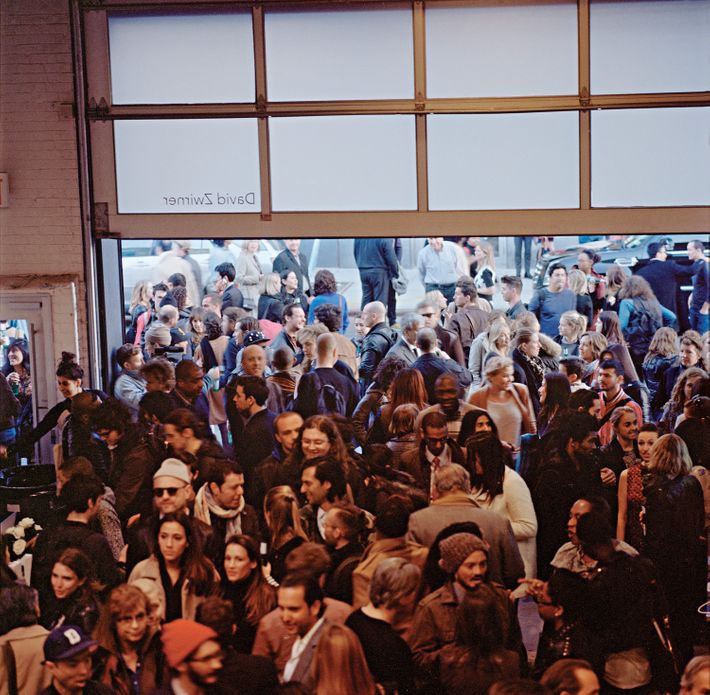
But there is now shuffling concern that collectors are declaring him significant, possibly even writing him into art history, before the curators and critics who have always made it their job to decide get a chance. ÔÇ£ItÔÇÖs quite a new phenomenon for the market to have this kind of influence,ÔÇØ says Cesar Garcia, a Los Angeles curator who showed Murillo earlier this year at his space, the Mistake Room. Another was more pointed: ÔÇ£He went from an art fair to an auction house without basically having shows anywhere.ÔÇØ Murillo might have been the most pointed; he called his show at GarciaÔÇÖs gallery ÔÇ£Oscar Murillo: Distribution Center.ÔÇØ In the last year, heÔÇÖs had solo shows at a string of unimpeachable spacesÔÇöthe South London Gallery, Isabella Bortolozzi in Berlin, Zwirner, Marian Goodman in ParisÔÇöand been promised a place in a painting survey at MoMA.
There used to be a certain backroom mystery as to what artworks exactly were for sale and to whom, but Murillo is young enough to have known only the new, more transparent click-to-buy era, when collectors sometimes shop by JPEG and art advisers plug things via Instagram, and both engage in the practice known as ÔÇ£flippingÔÇØ (early buyers buy cheap, sometimes in bulk, reselling for a profit). The art-world hustle doesnÔÇÖt seem to bother Murillo; being comfortable around money and money-talk is one sign of his ÔÇ£outsiderÔÇØ-ness. Some artists donÔÇÖt like the shopping-cart vibe of art fairs, but Murillo is known for going. (There he was on my Instagram feed last month, caught by @theartreporter in front of a Gerhard Richter at Art Basel.) ÔÇ£Three years ago, he was at every fair, wandering around with his little backpack,ÔÇØ says a member of the traveling art tribe who admires MurilloÔÇÖs pluck. ÔÇ£Telling collectors, ÔÇÿHey, how are you, man? Come over, IÔÇÖll cook for you!ÔÇÖ All these rich white collectors were following him around: ÔÇÿOscar! Oscar! Oscar!ÔÇÖÔÇëÔÇØ
One of those collectors who fell hard for him is the art adviser Stefan Simchowitz, who has bought 34 Murillo works for himself since 2011 (for as little as $1,500) and a similar number for clients (who include the actor Orlando Bloom and New York Giants owner Steve Tisch). He has become known as a sort of art-flipper bogeymanÔÇödespite never, he insists to me and on Facebook, having flipped a Murillo in his own collection (work heÔÇÖs gotten for others, however┬áÔǪ). He believes MurilloÔÇÖs selling a painting to a wealthy collector is like a graffiti artist ÔÇ£tagging a home.ÔÇØ Rich people ÔÇ£are clueless and should be educated and not just be parasitic socialites. And I think that is what OscarÔÇÖs art does,ÔÇØ Simchowitz says. ÔÇ£In this expensive, fancy home arrives this ÔÇÿtrophyÔÇÖ that is actually more a Trojan horse.ÔÇØ Or, as Murillo put it in a recent edition of the very glossy LÔÇÖOfficiel Art (which features a photo of his uncle Carlos sunk in bubbles in the bathtub of a 1930s Beverly Hills villa, owned by a collector, that they were staying in during the Mistake Room show): ÔÇ£Any opportunity of artistic achievement comes with an opportunity to infiltrate a social class.ÔÇØ
Murillo was born, and spent the first ten years of his life, in La Paila, a small town in the Cauca Valley of Colombia, where sugarcane has been harvested since it was brought by the Spanish in the 16th century. Enslaved Africans were imported to work the plantations, and to this day their descendants, now a mix of hues, still live there, many employed in the confectionery industry. For almost a century, the local company Colombina has been owned by the Caicedo family, sugar barons whose complexion trends lighter than those of their workers and who control everything from the farms to the sprawling candy factory to the local f├║tbol leagues.
As a child, Murillo says, ÔÇ£I obviously knew who the owners were. But on my radar, they were so distant. They run the region.ÔÇØ That Murillo enlisted the company to help him stage his New York debutÔÇöColombinaÔÇÖs dashing silver-haired executive C├®sar Caicedo did it for ÔÇ£the cachet,ÔÇØ Murillo thinksÔÇöis a delicious class-crashing achievement. ÔÇ£My grandfather passed awayÔÇöif he was alive now, heÔÇÖd be astonished,ÔÇØ Murillo says. ÔÇ£The closest he got to that family was in the ÔÇÖ60s; they did a lot of lobbying, so they would take the train from the village to Cali,ÔÇØ the regional capital, ÔÇ£and my grandfather would hand out Colombina chewing gum. To see this almost-equal-terms relationship, my grandfather wouldnÔÇÖt believe.ÔÇØ
MurilloÔÇÖs show at Zwirner, ÔÇ£A Mercantile Novel,ÔÇØ opened April 24 and came down in mid-June, eight weeks that enclosed a neat allegory about the art worldÔÇÖs limited patience for the undeferential. ÔÇ£HereÔÇÖs a gallery which is, according to experts or whatever, one of the most successful in the world,ÔÇØ says Murillo, and it let him do something few others would have: not show any paintings. Instead, he set up a satellite single-machine Colombina chocolate factory. An assembly line of 13 workers produced about 5,000 Chocmelo candies a dayÔÇöchocolate on the outside, white marshmallow within.
The factory conceit is not new in art; neither is even the idea of making chocolates in galleries (both Dieter Roth and Paul McCarthy had done so, and the art world ate it up.) But MurilloÔÇÖs version was more evasive and personal, almost to the point of not being discernible. He had the workers video-record their time here, as if to say they were the ones watching New York, not the other way around. They were put up in Crown Heights, given English lessons two days a week, and ate every Friday with the largely female coterie of flawlessly cosmopolitan gallery employees. One of those staffers who spoke Spanish translated for me with a few of the chocolatiers while they hand-sealed custom-designed foil bags full of Chocmelos. None had ever been to the U.S. before; most had never left Colombia. They had first heard that Murillo had made it big as an artist when a Colombian newspaper reported Leonardo DiCaprio had bought one of his paintings. They were surprised that New Yorkers ate so much salad, and all planned to come back.
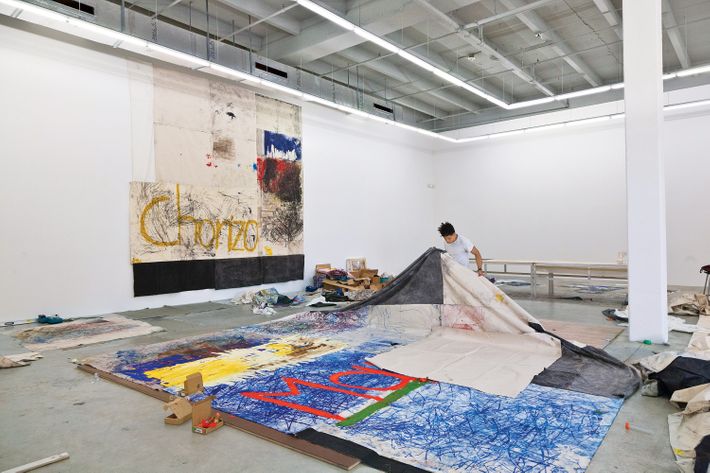
The Studio Museum in Harlem had originally invited Murillo to exhibit this spring. For a while, there was a plan to co-produce that show with Zwirner. But it turned out the gallery could accommodate the project better than the museum. Besides, Murillo says, ÔÇ£after kind of cementing the relationship, well, obviously Zwirner and I have to have sex in public together.ÔÇØ He then emphasizes that ÔÇ£A Mercantile NovelÔÇØ was not just a gallery loss leader. ÔÇ£I mean, this is definitely not just being paid for by David Zwirner,ÔÇØ he says. ÔÇ£This is also me paying for it.ÔÇØ
But there was merchandise to move. Collectors could buy one of the gleaming crates stocked with one shiftÔÇÖs worth of the candies for $50,000. On one wall was a huge blown-up photo of his mother in her Colombina work uniform, head down, clearly exhausted from her labor. She lost that job in the mid-1990s, prompting the family move to London. On a stainless-steel Ikea shelf below the photo, Murillo had placed boxes of Jeff KoonsÔÇôbranded Dom P├®rignon, each with a drawing of the Venus of Willendorf ancient fertility totem on copies of his motherÔÇÖs employment file (ÔÇ£RETIRADAÔÇØ). Interspersed were vases filled with melted chocolate and tennis balls on the shelf, which looked a bit like votive candles. The accumulated installation with its accumulated metaphors is called To the History of My Venus and was for sale. One afternoon when I stopped by the gallery, I saw the billionaire hedge-funder and collector Steve Cohen there,┬áasking Murillo questions about it.
MurilloÔÇÖs parents moved to London when he was 10 and knew no English. They are ambitious but not cultured people and worked as janitors; his father chose London, Murillo says over lunch, out of ÔÇ£na├»vet├®ÔÇØ: ÔÇ£He was a huge fan of The Saint, this show with Roger Moore. ItÔÇÖs like the Bond movies: There is this assumption that London is the center of things, the birth of culture.ÔÇØ At first, he says, Murillo felt ÔÇ£an astonishing cultural displacement,ÔÇØ which turned him into what he calls an ÔÇ£amalgamation.ÔÇØ Which is to say, a highly adaptable and restless person, but one who defines himself as an outsiderÔÇösomeone who has a ÔÇ£hesitation to fit in.ÔÇØ
ÔÇ£At the time, London wasnÔÇÖt what it is now,ÔÇØ he says, and even now, ÔÇ£itÔÇÖs not the most interesting place to liveÔÇöitÔÇÖs kind of always, like, gray. But they managed to create this structure that is attractive to the world, and so they have wealthy people coming in and they inject money, and so the whole thing can function.ÔÇØ Murillo was a jockÔÇöhe played on the junior Arsenal soccer teamÔÇöand good at drawing. But when I asked him how his artistic talent was first recognized and encouraged, he said, ÔÇ£There wasnÔÇÖt a recognition at first.ÔÇØ When he went to art school at University of Westminster to study animation, ÔÇ£I thought, If all else fails there is a kind of structure. But I only lasted two weeks. It was stop-motion, so to get a minute of animation, you have to draw for two months. And that was not much like me. So I went to speak to the fine-art people, and they liked my portfolio and took me in.ÔÇØ
After graduating in 2007, he worked as a teacher in a secondary school. ÔÇ£But I found it incredibly depressing,ÔÇØ he says. ÔÇ£It was bureaucratic, and I was kind of just telling kids to behave. I wasnÔÇÖt actually teaching them anything. And I would work on my stuff in the evenings. And I thought: I have to stop this.ÔÇØ He quit his job and traveled to South America with his wife, Angelica Fernandes, whose family is from Venezuela and whom Murillo had been dating since he was 16 and she 15. ÔÇ£She doesnÔÇÖt have nothing to do with the art world, but the sheer kind of loyaltyÔÇöitÔÇÖs amazing,ÔÇØ he says.
In 2009, ÔÇ£I find out sheÔÇÖs pregnant, and┬áI think, Oh, fuck, if IÔÇÖm going to take serious this art thing, I have to rethink my whole structure of survival.ÔÇØ For the next few years, during which he got his masterÔÇÖs at the Royal College of Art, he worked cleaning toilets at LondonÔÇÖs so-called Gherkin building. He had the 28th floor, with its incredible views across the city, all to himself. ÔÇ£I worked from four oÔÇÖclock in the morning till eight, and by nine oÔÇÖclock I would be in the studioÔÇöuntil nine oÔÇÖclock in the evening.ÔÇØ His wife got a degree in teaching but ÔÇ£kind of took the back seat and took care of the baby,ÔÇØ he says.
Over the next couple of years, he staged a series of memorably class-conscious shows in London: ÔÇ£The CleanersÔÇÖ Late Summer Party With Comme des Gar├ºons,ÔÇØ at the Serpentine, in which fellow janitors danced with the art world; a show turning a gallery into a yoga studio; an installation at the South London Gallery ÔÇ£with canvasses on the floor, very much works in progress, sculptures for corn and grinders for corn,ÔÇØ as the curator Margot Heller puts it, raising the question ÔÇ£What is waste and what is commodity?ÔÇØ The show also included a lottery with ┬ú2,500 tickets whose second prize was a trip to Mexico not for the ticket holder but for a friend of MurilloÔÇÖs from La Paila. First prize was a collection of mementos from a trip Murillo had taken back to Colombia. David Zwirner found himself with the┬áwinning ticket.
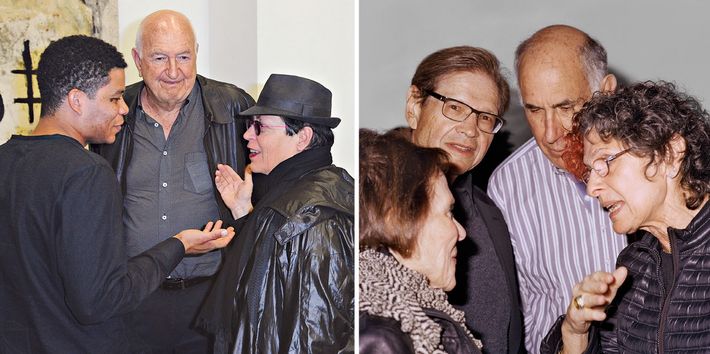
MurilloÔÇÖs true ascent began only when he met the Rubells. They had begun collecting as newlyweds in New York in the mid-1960s, setting aside $25 a week to collect artÔÇöthey were early believers in Basquiat, Richard Prince, Mike Kelley, and Keith HaringÔÇöand discovered Murillo two years ago at the Independent Art Fair, where he was showing with a London gallery, Stuart Shave.
ÔÇ£I think in general a lot of good artists have a rush at one time or another,ÔÇØ says Donald Rubell, fresh from his morning tennis game, when we meet up at the gallery a couple of weeks after the raucous opening of ÔÇ£A Mercantile Novel.ÔÇØ It had spilled┬áout onto the street, with blaring salsa┬áand food trucks, but the Rubells, who are now based in Miami, couldnÔÇÖt make it up.
ÔÇ£You know, Schnabel had a rush in the ÔÇÖ80s,ÔÇØ says Mera Rubell, in a billowing pin-striped coat, a fedora over her spiky hair. ÔÇ£Haring had a rush. Basquiat had a rush.ÔÇØ
ÔÇ£Jasper JohnsÔÇÖs first showÔÇöthey were $900, but they all sold out in minutes,ÔÇØ says Donald. ÔÇ£It doesnÔÇÖt define a good or a bad artist. A lot of bad artists also have a rush.ÔÇØ
ÔÇ£But we become suspicious at that,ÔÇØ says Mera. ÔÇ£Because we think thereÔÇÖs some evil or manipulative force. You think that itÔÇÖs premeditated. You think itÔÇÖs like a kind of intentional commercial drive. But, just in our experience, itÔÇÖs hard to create it.ÔÇØ
We are sitting next to the chocolate machine, while the workers are on break, and the Rubells are performing for my benefit a remarkably unguarded account of their relationship to Murillo and their feelings about his work. ÔÇ£We have not had a sit-down like this with David Zwirner about Oscar,ÔÇØ complains Mera. ÔÇ£And it bugs the shit out of me. YouÔÇÖd think he would call us up and say, ÔÇÿWho is Oscar?ÔÇÖ We know him so well.ÔÇØ
They hadnÔÇÖt yet heard of him when they saw his work at the Independent in 2012, they tell me. ÔÇ£But all the paintings were already sold,ÔÇØ says Mera. They knew the gallerist. ÔÇ£Stuart said, ÔÇÿI wish I knew you were interested.ÔÇÖ We said, ÔÇÿHow could we know we were interested?ÔÇÖ WeÔÇÖd never heard of this artist. We thought, We need to meet this young artist becauseÔÇöÔÇØ
ÔÇ£ItÔÇÖs not just who he is; itÔÇÖs who he can become,ÔÇØ says Donald.
Murillo had no work left at his Hunter studio. When Shave told him that the Rubells were visiting, he decided to spend the next two days on a painting bender.
ÔÇ£We arrive at Hunter at 9 a.m., and he has now painted for 48 straight hours. He hijacked this big space because everyone else had left for Easter holiday,ÔÇØ Mera says. He looked exhausted after the binge. ÔÇ£When we met him, we thought he was a homeless person,ÔÇØ says Mera.
ÔÇ£I immediately held on to my pockets and headed to the door,ÔÇØ says Donald.
But then they took a look at his work. ÔÇ£We couldnÔÇÖt believe the energy,ÔÇØ says Donald.
ÔÇ£ThereÔÇÖs one painting there, Milk, and I say to Oscar: ÔÇÿHave you ever made a painting this good?ÔÇÖÔÇëÔÇØ says Mera. ÔÇ£ÔÇëÔÇÿBecause I canÔÇÖt imagine anybody making a better painting than this one.ÔÇÖÔÇëÔÇØ The Rubells agreed to buy the whole batch. Then they did something they hadnÔÇÖt before: offer to let him use one of the galleries in their foundation, a former DEA facility in Miami adjacent to their home, while theyÔÇÖd be away that summer.
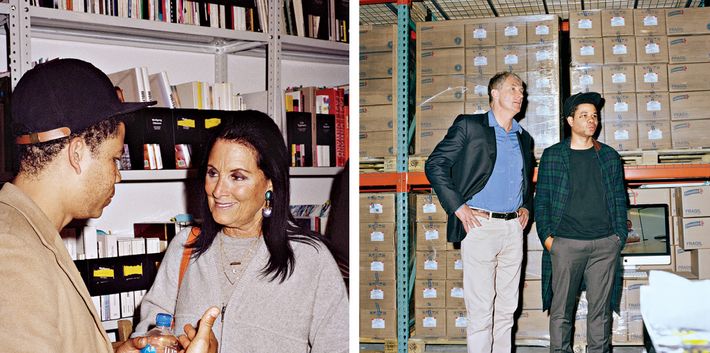
ÔÇ£People are always trying to figure out what the power of the immigrant is,ÔÇØ says Mera.
ÔÇ£No, theyÔÇÖre not,ÔÇØ says Donald.
Let me just finish my point. The power of the immigrant is that they always show up. You dont always know if you can deliver, but you always show up. Oscar always shows up. We give him 24-hour access to the space, and every day we get these updates: Look at what he did last night, look at what he did this morning, look look look. He makes over 40 works in six weeks  and he was cooking sausages for the staffMr. Paisa brand.
When they returned, they said they wanted to buy it all and put on a show at their foundation. But there was some disagreement: Murillo sought to exhibit everything that went into the process of making the work ┬¡(including the sewing machine). But they knew better. ÔÇ£We said, ÔÇÿThe world does not know you, Oscar,ÔÇÖÔÇëÔÇØ Donald remembers. ÔÇ£ÔÇëÔÇÿThe first go-around, the world should know the best that you can do. As elegant a setting as you can.ÔÇÖÔÇëÔÇØ
ÔÇ£If he had his choice, he would have left the paintings on the ground,ÔÇØ says Mera. ÔÇ£HeÔÇÖs not comfortable being so historical. HeÔÇÖs a little embarrassed to be monumental. HeÔÇÖs a little bit intimidated by what heÔÇÖs created. But when the frames arrived and he put the paintings up on them, it was like a moment of silence.ÔÇØ
ÔÇ£Oh my God,ÔÇØ recalls Donald.
ÔÇ£We end up showing just five paintings,ÔÇØ Mera says. The show opened during Art Basel Miami in December 2012. And that was the beginning of Oscar Murillo, art star.
But the Rubells werenÔÇÖt finished with him. ÔÇ£It happens weÔÇÖre friends with some Colombians in Miami,ÔÇØ says Mera. ÔÇ£We tell them we met this Colombian artist who now lives in London, whoÔÇÖs from this small town where his family cuts sugarcane with machetes. And not only do they know the town, but this person that we knowÔÇöhis uncle owns the factory.ÔÇØ
ÔÇ£TheyÔÇÖre our best friends in Miami,ÔÇØ says Donald. They set up a meeting in their living room between C├®sar Caicedo and Murillo. ÔÇ£And it was fascinating ÔǪ And the first thing they said was, ÔÇÿOscar doesnÔÇÖt have an upper-class accent.ÔÇÖÔÇëÔÇØ Upon meeting, Caicedo and Murillo ÔÇ£both assumed the traditional roles that they had in this town. There was a lot of tension.ÔÇØ
ÔÇ£Not tension,ÔÇØ says Mera. ÔÇ£He was returning to the core of his identity. Of this town, this family, working in this place. It comes back to, you donÔÇÖt bring your history of poverty and lower-class family when youÔÇÖre being wined and dined by money and power,ÔÇØ she says. ÔÇ£You just donÔÇÖt! Look, IÔÇÖm an immigrant. My earliest memory is of a displacement camp in Germany. For me, this fantasy of going back to a place where you can show how far and how lucky and how fortunate ÔǪ In that living room, talking to C├®sar, you could feel Oscar saying to himself, ÔÇÿBut for the grace of God, I am here.ÔÇÖÔÇëÔÇØ
ÔÇ£That sounds like a B-movie.ÔÇØ
ÔÇ£Some artists have compelling stories,ÔÇØ counters Mera. ÔÇ£And Oscar, from when we first met him, there was this feeling that, They want to know me for my story, and then they want to crucify me for my story. ItÔÇÖs too good a story.ÔÇØ
ÔÇ£He didnÔÇÖt have any paranoia about people crucifying him for his story.ÔÇØ
ÔÇ£No, I think he was conscious of it.ÔÇØ
ÔÇ£We in the art world were conscious of it.ÔÇØ
ÔÇ£I mean, he cut his hair. HeÔÇÖs trying to be himself. I mean, people are comparing him to Dieter Roth. HeÔÇÖs Paul McCarthy,ÔÇØ Mera says. ÔÇ£They think that this is some kind of gimmick. And I understand why they would think it is some kind of gimmick.ÔÇØ
Oscar is a very, very intuitive person, says Donald. He understands its important for him to somehow maintain 
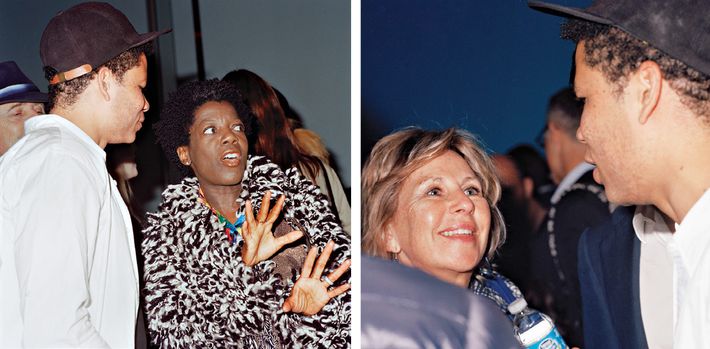
ÔÇ£The core of his identity,ÔÇØ says Mera. ÔÇ£ItÔÇÖs almost like he needs to remember. As an immigrant kid, my parents embarrassed the hell out of me for so many years. You donÔÇÖt know how embarrassing it is when your parents donÔÇÖt speak the language. They donÔÇÖt dress right. But Oscar from the very beginning wasnÔÇÖt embarrassed to bring his parents into his universe.ÔÇØ
ÔÇ£This is something we disagree about,ÔÇØ says Donald, by which he means the biographical aspect of the painting-free Zwirner show. ÔÇ£To me, Oscar is blessed. HeÔÇÖs an artist. And yes, this is very important to him,ÔÇØ he says, waving his hand at the factory. ÔÇ£But heÔÇÖs really a great painter. Well, no young artist can be a great painter. HeÔÇÖs a very good painter. He has enormous promise. This,ÔÇØ he continues, waving his hand again, ÔÇ£is something else. But Mera thinks this is the essenceÔÇöÔÇØ
ÔÇ£Donald, youÔÇÖre stuck on him as a painter.ÔÇØ
ÔÇ£I donÔÇÖt reject this per se,ÔÇØ says Donald. ÔÇ£But there is no way the story of the artist is the essence of an artist. The essence of the artist is what he can do with the story.ÔÇØ He adds: ÔÇ£ItÔÇÖs a rare thing when you see someone with so much raw talent. All the cynics on Oscar are not relating to work theyÔÇÖve seen. ItÔÇÖs work they havenÔÇÖt seen. With Oscar, once you see the workÔÇöno one stands in front of his work and says, ÔÇÿNot interesting work.ÔÇÖ You could argue things like the market is too high, itÔÇÖs too fast, but the money is irrelevant. Whether it costs a lot or costs a little, either the art is good or it isnÔÇÖt.ÔÇØ
ÔÇ£The artist becomes victimized because the auction market goes where it goes,ÔÇØ says Mera. ÔÇ£What is dangerous for Oscar is that with all these accusationsÔÇöheÔÇÖs copying this one, heÔÇÖs copying that oneÔÇöis that he has to be careful that he doesnÔÇÖt give up territories which are uniquely his. No one paints with a broomstick. His technique is so unique to him. His signature is literally a handprint. When I see those strokes, I think itÔÇÖs a subliminal memory of his grandfather machete-ing his sugarcane.ÔÇØ
Or perhaps, Donald suggests, itÔÇÖs just that he worked with a broom as a cleaner.
ÔÇ£I think we have memories we donÔÇÖt even know,ÔÇØ says Mera.
It was early in the afternoon on June 14, the last day of MurilloÔÇÖs show, and he was back in town after the ÔÇ£more civilizedÔÇØ Marian Goodman opening in Paris, making more of those vases filled with melted chocolate and tennis balls. Salsa music was blaring.
The coverage of ÔÇ£A Mercantile NovelÔÇØ had been brutal, even mocking. At the press preview, Murillo had seemed defensive. ÔÇ£It isnÔÇÖt about bringing people from a foreign country and getting them to do work,ÔÇØ he tried to tell reporters, stumbling to explain his use of the word novel. But the preview was thronged by both enthusiasts and doubters. BloombergÔÇÖs reporter opened her dispatch: ÔÇ£ÔÇëÔÇÿI am not a star,ÔÇÖ artist Oscar Murillo said as he signed autographs.ÔÇØ
ÔÇ£For his first solo show in New York, the hot young painter Oscar Murillo has blinked,ÔÇØ wrote the Times in a not atypical assessment, going on to call the show ÔÇ£obvious,ÔÇØ ÔÇ£laborious,ÔÇØ ÔÇ£macho,ÔÇØ and ÔÇ£self-flattering.ÔÇØ The Art Newspaper ran a story about the reaction, succinctly headlined: ÔÇ£Haters gonna hate.ÔÇØ The show didnÔÇÖt give many people what they wanted, a look at the paintings, and instead gave them something that was difficult to engage with. Later, at Frieze, when I was introduced to Laura Hoptman, who is curating the upcoming MoMA show, and the museum trustee A.ÔÇëC. Hudgins, who is a big supporter of MurilloÔÇÖs, neither was in a mood to talk.
Zwirner blamed it on ÔÇ£a pattern in the local press where theyÔÇÖre very hard on young artists who donÔÇÖt live here, who come from other places.ÔÇØ One Zwirner-ite thought there had been a whisper campaign by Gavin Brown, who represents an artist, Joe Bradley, whose paintings look a bit like MurilloÔÇÖs.
When we had lunch, Murillo referred to himself as ÔÇ£a young emerging artist,ÔÇØ as if that in itself might tamp down expectations. ÔÇ£I guess in my head I know what IÔÇÖm doing,ÔÇØ he told me later at the gallery, clutching two iPhones as we discussed his critics and their misunderstandings. ÔÇ£You know, I think the problem is the need for information, immediacy, means that people donÔÇÖt look. People donÔÇÖt look or people donÔÇÖt see.ÔÇØ
At the gallery for that last day, I poked my head through the plastic flaps that obscured the assembly line from the public area. The workers and Murillo were celebrating: TheyÔÇÖd been watching the World Cup, and Colombia had soundly beaten Greece 3-0. Murillo was polite, as always, but he told me that he was done talking. All of this had been enough.
*This article appears in the June 30, 2014 issue of New York Magazine.


